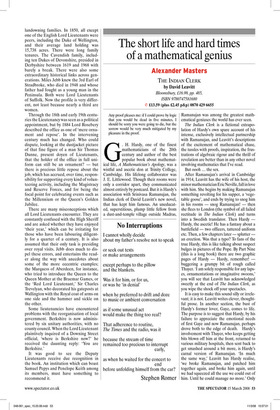The short life and hard times of a mathematical genius
Alexander Masters
THE INDIAN CLERK by David Leavitt Bloomsbury, £16.99, pp. 485, ISBN 9780747581680 ✆ £13.59 (plus £2.45 p&p) 0870 429 6655
Any proof pleases me: if I could prove by logic that you would be dead in five minutes, I should be sorry you were going to die, but the sorrow would be very much mitigated by my pleasure in the proof.
G. H. Hardy, one of the finest mathematicians of the 20th century and author of the best popular book about mathematical life, A Mathematician’s Apology, was a wistful and ascetic don at Trinity College, Cambridge. His lifelong collaborator was J. E. Littlewood. Though their rooms were only a corridor apart, they communicated almost entirely by postcard. But it is Hardy’s association with Srinivasa Ramanujan, the Indian clerk of David Leavitt’s new novel, that has kept him famous. An uneducated, superstitious, plump little fellow from a dust-and-temple village outside Madras, Ramanujan was among the greatest mathematical geniuses the world has ever seen.
The Indian Clerk is a fictional extrapolation of Hardy’s own spare account of his intense, exclusively intellectual partnership with Ramanujan, and Leavitt’s descriptions of the excitement of mathematical chase, the tussles with proofs, inspiration, the frustrations of algebraic rigour and the thrill of revelation are better than in any other novel involving mathematics that I’ve read.
But oooh ... the sex.
After Ramanujan’s arrival in Cambridge in 1914, Leavitt has the wife of his host, the minor mathematician Eric Neville, fall in love with him. She begins by making Ramanujan something revolting for his supper, a ‘vegetable goose’, and ends by trying to snog him in his rooms — snog Ramanujan! — then she flees to London (the symbol of all failed rectitude in The Indian Clerk) and turns into a Swedish translator. Then Hardy — Hardy, the ascetic! He has a fantasy about a battlefield — two officers, tattered uniform etc. Then, a few chapters later — splutter — an erection. Was that a typo? To fans of the true Hardy, this is like talking about suspect bulges in pictures of the Pope. By Part Nine (this is a long book) there are two graphic pages of Hardy — Hardy, remember! — buggering a grumpy bit of rough called Thayer. ‘I am solely responsible for any lapses, ornamentations or imaginative swoons,’ you will see that Leavitt has acknowledged sweetly at the end of The Indian Clerk, as you wipe the shock off your spectacles.
It is easy to make this sound silly or irrelevant; it is not. Leavitt writes clever, thoughtful prose. In another section, the bust of Hardy’s former lover, Gaye, comes to life. The purpose is to suggest that Hardy, by his failure to appreciate the emotional needs of first Gaye and now Ramanujan, perhaps drove both to the edge of death. Hardy’s involvement with Thayer, who keeps getting bits blown off him at the front, returned to various military hospitals, then sent back to get smashed around a bit more, is Hardy’s carnal version of Ramanujan. ‘In much the same way,’ Leavitt has Hardy realise, ‘we broke Ramanujan, and patched him together again, and broke him again, until we had squeezed all the use we could out of him. Until he could manage no more.’ Only then did they let him go back to India.
Trinity does not come out well in this story either. Reluctant to bring Ramanujan over, stingy with money and support once he had arrived, it at first refused to elect him to a fellowship on grounds that included not wanting a nigger on the staff, and until recently at least, there was no portrait of Ramanujan, their greatest intellect since Newton, anywhere in the building. In late 1917 or early 1918 Ramanujan tried to jump under a train. Permanently cold, fed on food he detested, he contracted an illness that might have been tuberculosis, and was sent to a sanatorium where he had to hide in the toilet, the only warm place in the building, to scribble down the results of his startling mathematical explorations. Partition Functions, the Riemann Hypothesis, the Zeta Function, the distribution of primes, Ramanujan’s own charming inventions of ‘rounded numbers’ and highly composite numbers: Leavitt manages to convey some of the importance and extraordinariness of them all.
At the end of the war, Ramanujan returned to India, where his decline became rapid. He died a year later. He was 33.
I still say to myself when I am depressed [Hardy wrote in A Mathematician’s Apology] and find myself forced to listen to pompous and tiresome people, ‘Well, I have done one thing you could never have done, and that is to have collaborated with both Littlewood and Ramanujan on something like equal terms.’



























































































 Previous page
Previous page